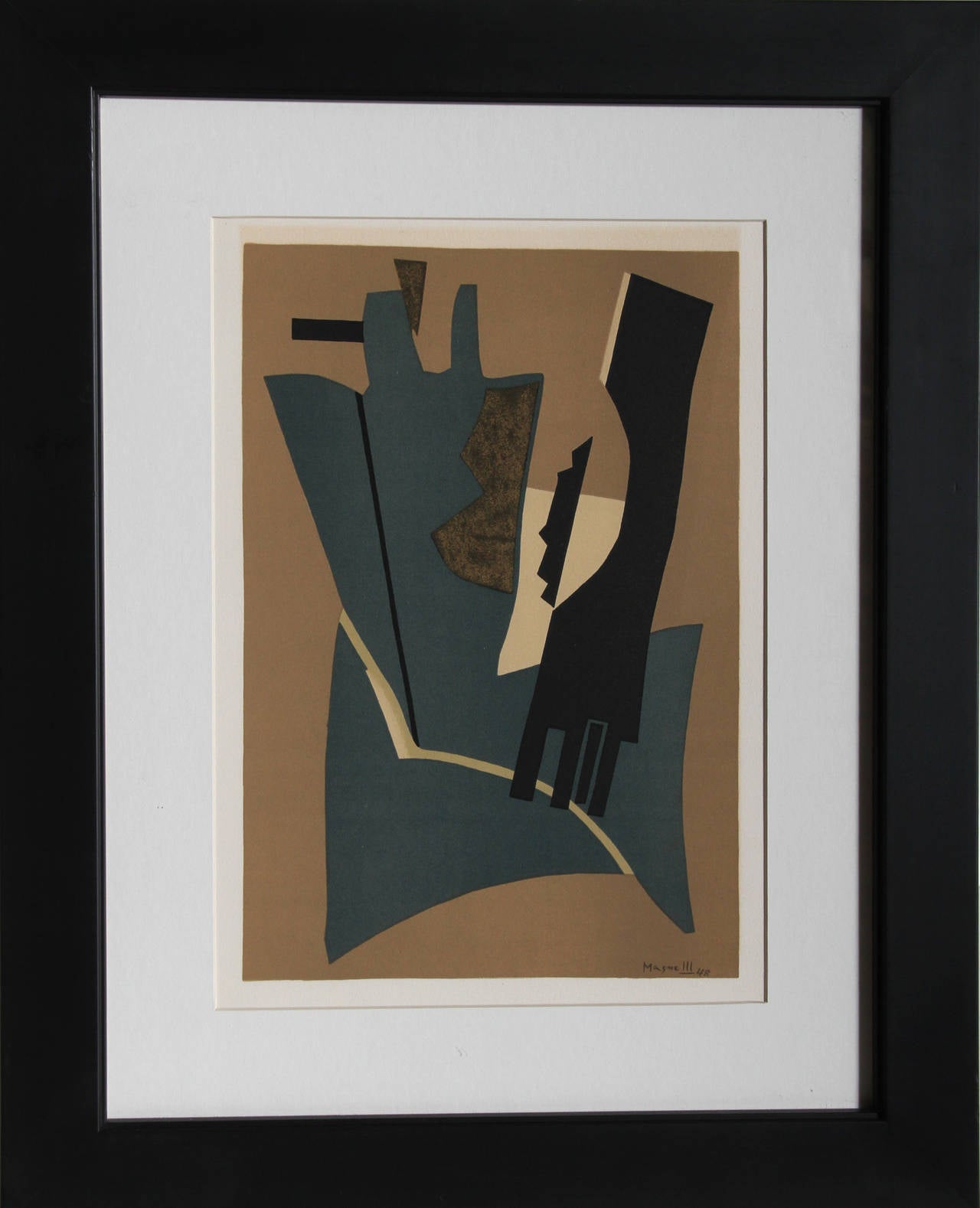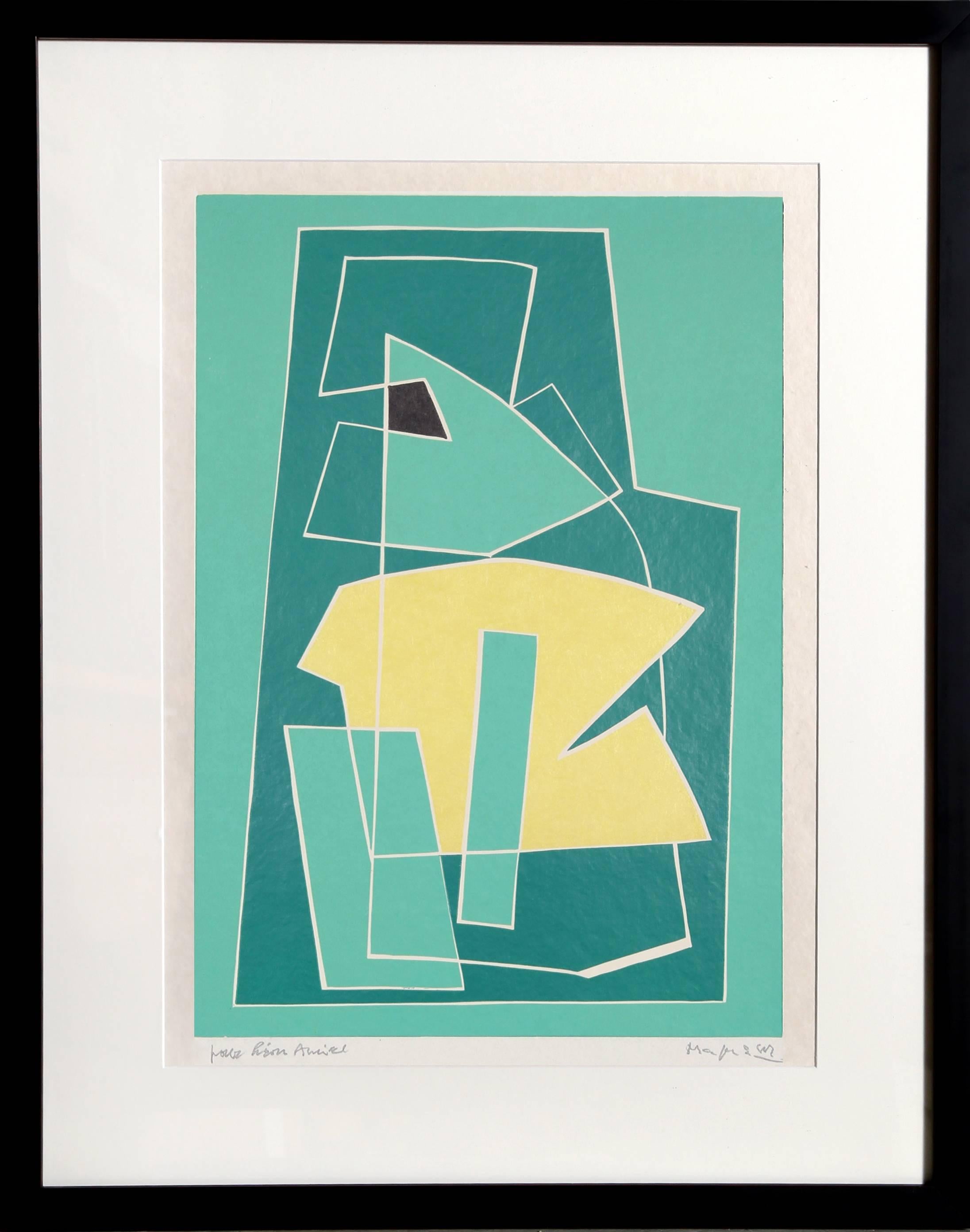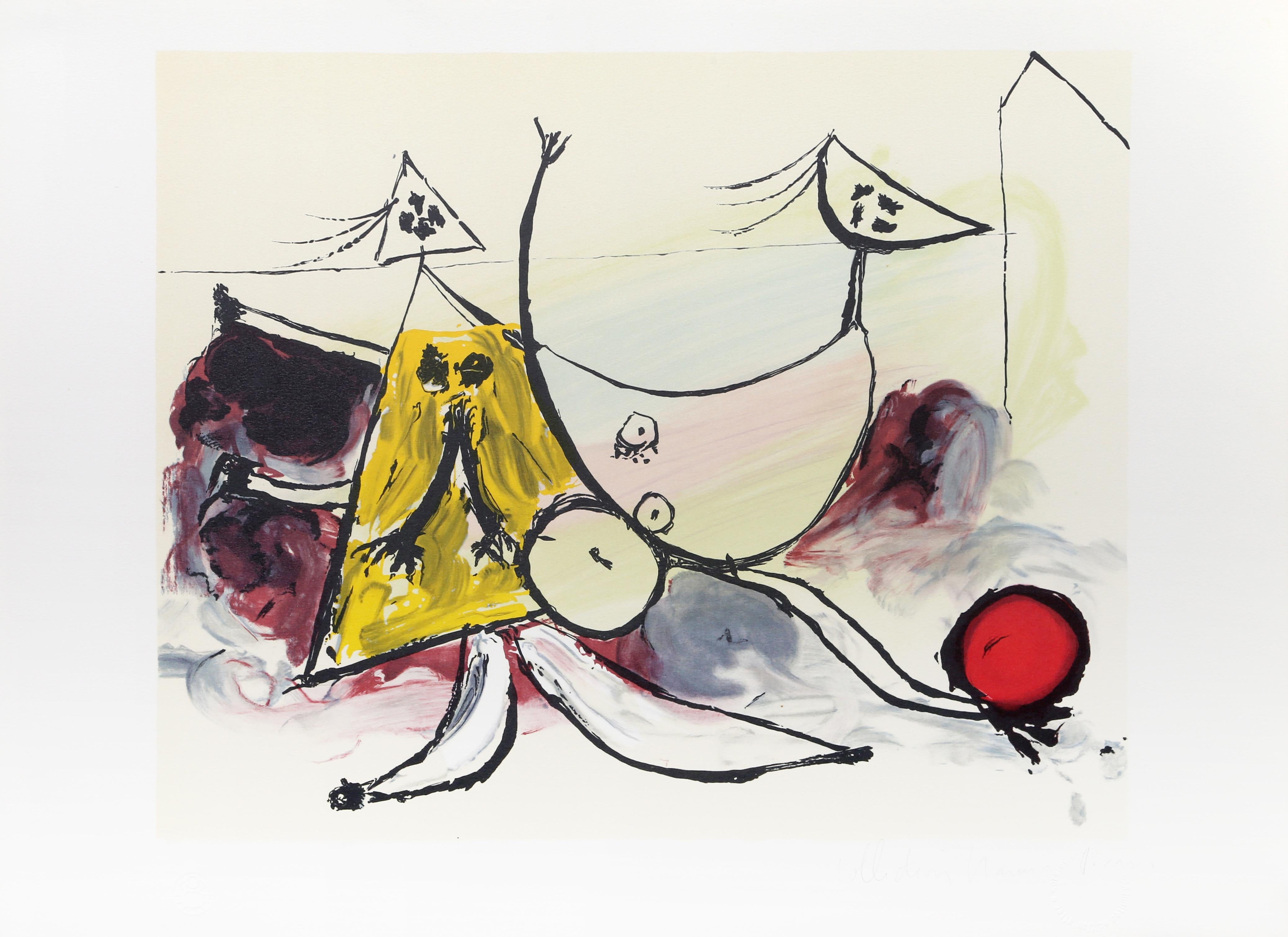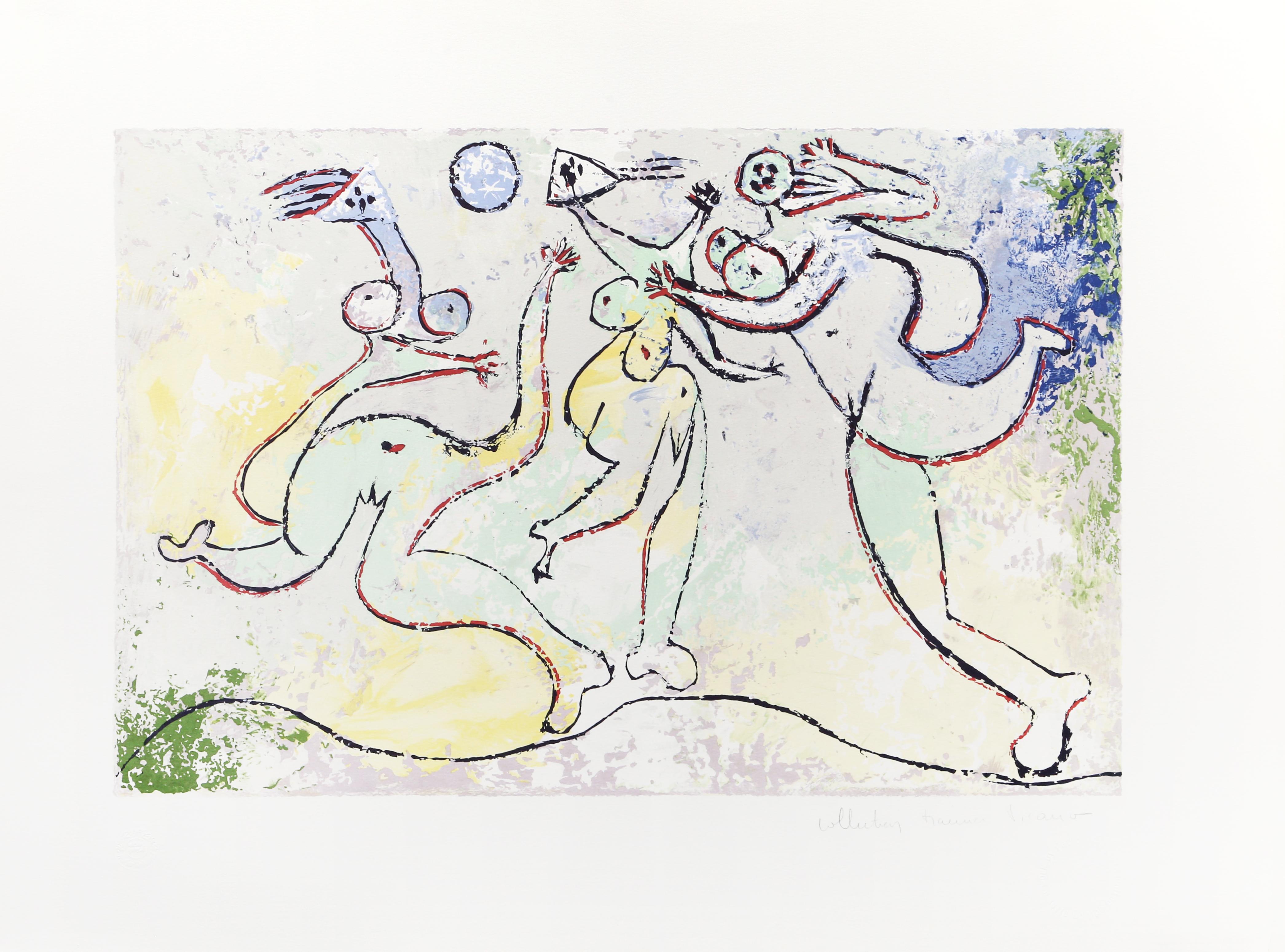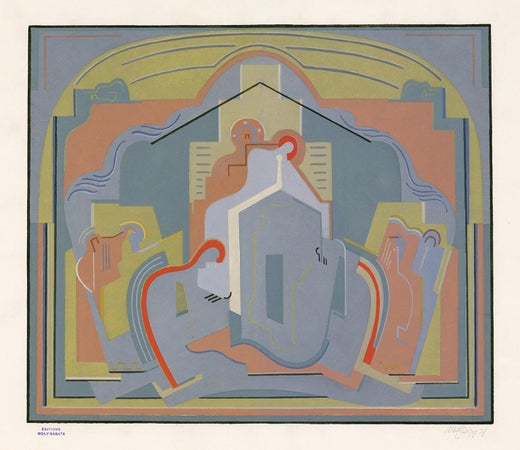Items Similar to 'Descente de Croix' (Descent from the Cross) — 1920s French Cubism
Want more images or videos?
Request additional images or videos from the seller
1 of 6
Albert Gleizes'Descente de Croix' (Descent from the Cross) — 1920s French Cubism1928
1928
About the Item
Albert Gleizes, 'Descente de Croix', color pochoir, 1928, edition c. 50. Signed and dated in pencil. A fine, painterly impression, with fresh colors, on heavy, cream wove paper; the full sheet with margins (3 to 4 inches), in very good condition. The publisher's ink stamp 'EDITIONS MOLY-SABATA' beneath the image, lower left. Matted to museum standards, unframed.
Image size 12 x 14 inches (305 x 356 mm); sheet size 18 x 22 inches (457 x 559 mm).
ABOUT THE IMAGE
After the 1927 painting 'Descente de Croix', one of three religious-themed works that Gleizes developed as preliminaries for murals at the church at Serrières, France, the project was terminated at its final phase, and Gleizes commissioned master printer Robert Pouyaud to create prints of the paintings, closely overseeing the production.
ABOUT THE MEDIUM
Pochoir is a refined stencil-based technique employed to create multiples or to add color to prints produced in other mediums. Characterized by its crisp lines and rich color, the print-making process was most popular from the late 19th century through the 1930s, with its center of activity in Paris. The pochoir process began with the analysis of an image’s composition, including color tones and densities. The numerous stencils (made of aluminum, copper, or zinc) necessary to create a complete image were then designed and hand-cut by the 'découpeur.' The 'coloristes' applied watercolor or gouache pigments through the stencils, skillfully employing a variety of different brushes and methods of paint application to achieve the desired depth of color and textural and tonal nuance. The pochoir process, by its handcrafted methodology, resulted in the finished work producing the effect of an original painting, and in fact, each print was unique.
ABOUT THE ARTIST
Albert Gleizes (1881-1953), born in Paris, France, was a pioneering figure in the development of abstract art and one of the leading proponents of Cubism. His contributions to the art world extended beyond his paintings; he was also a prolific writer and theoretician, advocating for a new approach to art that emphasized the geometric abstraction of form and a departure from representational traditions.
Gleizes initially studied painting at the Académie Julian and the École des Beaux-Arts in Paris, where he was exposed to the academic conventions of the time. However, his artistic vision was profoundly influenced by encounters with avant-garde movements, including Fauvism and the work of Paul Cézanne. These influences led Gleizes to experiment with form and color, gradually moving away from traditional representation toward a more abstract and geometric style.
After completing his secondary schooling, Gleizes spent four years in the French army and then began pursuing a career as a painter, primarily doing landscapes. Initially influenced by the Impressionists, he was only twenty-one years of age when his work titled ‘La Seine à Asnières’ was exhibited at the Société Nationale des Beaux-Arts in 1902. The following year, he was part of the first Salon d'Automne and soon came under the influence of Fernand Léger, Robert Delaunay, Jean Metzinger, and Henri Le Fauconnier. In 1907, Gleizes and some of his friends pursued the idea of creating a self-supporting community of artists that would allow them to develop their art free of any commercial concerns. For nearly a year, Gleizes , with other painters, poets, musicians, and writers, lived at a large house in Créteil, but a lack of funds forced them to give up their facility in early 1908, and Gleizes moved temporarily into La Ruche, the artist commune in the Montparnasse Quarter of Paris.
In the early 1910s, Gleizes became associated with the Cubist movement, which was spearheaded by artists such as Pablo Picasso and Georges Braque. Cubism sought to represent the multidimensional aspects of reality by breaking down forms into geometric shapes and exploring multiple perspectives within a single composition. Gleizes's contributions to Cubism were significant, as he co-authored the influential treatise "Du Cubisme" (On Cubism) with Jean Metzinger in 1912, outlining the principles and theories behind the movement.
With the outbreak of World War I, Albert Gleizes re-enlisted in the French army. He was put in charge of organizing entertainment for the troops and, as a result, was approached by Jean Cocteau to design the set and costumes for the William Shakespeare play, ‘A Midsummer Night's Dream.’ Discharged from the military in the fall of 1915, Gleizes and his new wife, Juliette Roche, the daughter of a prominent and wealthy French statesman, moved to New York City. From there, the couple sailed to Barcelona, Spain, where they were joined by Marie Laurencin, Francis Picabia, and his wife. The group spent the summer painting at the resort area of Tossa del Mar, and in December, Gleizes had the first solo exhibition of his works at the Galeries Dalmau in Barcelona. Returning to New York City, Gleizes began writing poetic sketches in verse and in prose. Traveling to Bermuda, he painted a number of landscapes, but when the war in Europe ended, he returned to France, where his career evolved into teaching through writing, and he became involved with the committee of the Unions Intellectuelles Françaises. In 1927, still dreaming of the communal days in Créteil, he founded an artist's colony at a rented house called the Moly-Sabata in Sablons near his wife's family home in Serrières in the Ardèche département in the Rhône Valley.
In 1931, Gleizes was part of the committee of Abstraction-Création that acted as a forum for international non-representational art. By this time, his work reflected the strengthening of his spiritual convictions, and his 1932 book, La Forme et l’histoire, examines Celtic, Romanesque, and Oriental art. On tour in Poland and Germany, he gave lectures titled Art et Religion, Art et Production, and Art et Science. In 1937, Gleizes was hired to paint murals for the Exposition Internationale des Arts et Techniques dans la Vie Moderne at the Paris World’s Fair. He collaborated with Delaunay in the Pavillon de l'Air and with Léopold Survage and Fernand Léger for the Pavillon de l'Union des Artistes Modernes. At the end of 1938, Gleizes volunteered to participate in the free seminars and discussion groups for young painters set up by Robert Delaunay at his Paris studio.
In the late 1930s, the wealthy American art connoisseur Peggy Guggenheim purchased a great deal of the new art in Paris, including works by Albert Gleizes. She brought these works to the United States, which today form part of the Peggy Guggenheim Collection. During World War II, Gleizes and his wife remained in France under the German occupation. His religious convictions deepened, and at the war's end, he was hailed by some as having laid out the principles for a renewal of religious art. In 1948, Gleizes accepted an offer from a publisher in Casablanca to create a series of etchings illustrating the ‘Pensées sur l'Homme et Dieu’ of Blaise Pascal. In 1951, he was made a jury member for the Prix de Rome, and the French government awarded him the Legion of Honor. In 1952, he completed his last major work, a fresco titled ‘Eucharist’ created for a Jesuit chapel in Chantilly.
Throughout his career, Gleizes remained dedicated to exploring the formal possibilities of abstraction while also incorporating elements of rhythm, color, and dynamic movement into his compositions. His style evolved over time, reflecting his ongoing engagement with modernist ideas and his interest in spirituality and metaphysics.
Albert Gelizes’ work is represented in numerous museums in the United States, the United Kingdom, and Europe including the British Museum (London), Los Angeles County Museum of Art, Musée d'Art Moderne de la Ville de Paris, Musée des Beaux-Arts de Lyon (Lyon, France), Musée de Grenoble (Grenoble, France), Musée National d'Art Moderne (Centre Georges Pompidou, Paris), Museum of Modern Art (New York), National Gallery of Art (Washington, D.C.), Peggy Guggenheim Collection (Venice, Italy), Solomon R. Guggenheim Museum (New York), The Metropolitan Museum of Art (New York), Philadelphia Museum of Art, Tate Modern (London).
- Creator:Albert Gleizes (1881-1953, French)
- Creation Year:1928
- Dimensions:Height: 12 in (30.48 cm)Width: 14 in (35.56 cm)
- Medium:
- Movement & Style:
- Period:
- Condition:
- Gallery Location:Myrtle Beach, SC
- Reference Number:
Albert Gleizes
Albert Gleizes (1881-1953) was a prominent French artist, theorist, and philosopher, best remembered as a pioneer of Cubism alongside artists like Picasso and Braque. Born in Paris, his early work was influenced by Impressionism, but by 1910, he had delved deep into the innovative world of Cubism, emphasizing geometrical forms and multiple viewpoints. With Jean Metzinger, he co-authored "On Cubism," a significant treatise that helped define and explain the movement's principles. Throughout his career, Gleizes continued to evolve his style, moving towards abstraction and integrating his fascination with rhythm and color. In addition to his visual contributions, his writings made him an influential voice in 20th-century art theory. A true visionary, Gleizes not only reshaped the art world with his creations but also laid the groundwork for future abstract artists with his profound insights into the essence of art.
About the Seller
5.0
Recognized Seller
These prestigious sellers are industry leaders and represent the highest echelon for item quality and design.
Platinum Seller
These expertly vetted sellers are 1stDibs' most experienced sellers and are rated highest by our customers.
Established in 1995
1stDibs seller since 2016
259 sales on 1stDibs
Typical response time: 1 hour
Associations
International Fine Print Dealers Association
- ShippingRetrieving quote...Ships From: Myrtle Beach, SC
- Return PolicyA return for this item may be initiated within 7 days of delivery.
More From This SellerView All
- Variation 4, Vol. IBy Katherine Sophie DreierLocated in Myrtle Beach, SCKatherine S. Dreier, 'Variation 4, Vol. I' from '1 to 40 Variations', lithograph with pochoir and hand-coloring, 1934, edition 65. Stenciled signature and date, lower right. Annotate...Category
Mid-20th Century American Modern Abstract Prints
MaterialsWatercolor, Lithograph, Stencil
- 'Variation 5, Vol. I' — from the series '1 to 40 Variations'By Katherine Sophie DreierLocated in Myrtle Beach, SCKatherine S. Dreier, 'Variation 5, Vol. I' from '1 to 40 Variations', lithograph with pochoir and hand-coloring, 1934, edition 65. Stenciled signature and date, lower right. Annotate...Category
Mid-20th Century American Modern Abstract Prints
MaterialsWatercolor, Lithograph, Stencil
- 'Sculpturegraph' — Modernist Abstraction, Contemporary African American ArtistLocated in Myrtle Beach, SCGeorge Rogers, 'Sculpturegraph' (Black, Gray, and Silver), color sculpturegraph, edition 40, 1984. Signed, dated, titled, and numbered '25/40' in pencil. A superb, richly-inked, pain...Category
1980s American Modern Abstract Prints
MaterialsMonoprint
- 'African Idol' — 1930s American ModernismBy Robert Vale FaroLocated in Myrtle Beach, SCRobert Vale Faro, untitled (African Idol), serigraph, c. 1940, edition 6. Signed in pencil. A fine impression, with fresh colors, on buff wove paper; the full sheet with margins(5/8 to 1 3/8 inches), in excellent condition. Very rare. Matted to museum standards, unframed. Image size 8 3/4 x 6 inches (222 x 152 mm); sheet size 11 x 7 1/2 inches (279 x 192 mm). ABOUT THE ARTIST Robert Vale Faro (1902-1988) was a well-known modernist architect and artist associated with the Chicago Bauhaus. He received his degree in architecture and design from the Armour Institute in Chicago and worked at L'Ecole des Beaux-Arts, Paris, from 1924-27, where he was influenced by Harry Kurt Bieg and Le Corbusier. Upon his return to Chicago, Faro worked with the important modernist Chicago architects George and William Keck under Louis Sullivan. Faro founded the avant-garde printmaking group Vanguard in 1945. The group counted Atelier 17 artists Stanley William Hayter, Sue Fuller, and Anne Ryan as New York members and Francine...Category
1940s American Modern Abstract Prints
MaterialsScreen
- Expressionist Abstraction — Hawaiian ArtistBy Tetsuo OchikuboLocated in Myrtle Beach, SCTetsuo "Bob" Ochikubo, 'Untitled (Abstract Expressionist Composition)', color lithograph, 1963, edition 3. Signed, dated, and numbered '3-3' in pencil. A fine, richly-inked impression, with fresh colors, on cream wove paper; the full sheet with margins (5/8 to 2 inches), in excellent condition. Very scarce. Image size 17 1/2 x 12 1/4 inches; sheet size 19 7/8 x 14 7/8 inches. Matted to museum standards, unframed. ABOUT THE ARTIST Tetsuo Ochikubo (1923–1975), also known as Bob Ochikubo, was a Japanese-American painter and printmaker who was born in Waipahu, Hawaii. After service in the US Army as an infantryman in Europe during World War II, Ochikubo studied painting and design at the School of the Art Institute of Chicago and the Art Students League in New York. He worked at the renowned lithography workshop Tamarind Institute in the 1960s and is best known for his non-objective paintings and lithographs. Ochikubo was a member of the Metcalf Chateau, a group of seven Asian-American artists with ties to Honolulu which included Satoru Abe...Category
1960s Abstract Abstract Prints
MaterialsLithograph
- 'Expansion' — Modernist Abstraction, Atelier 17By Stanley William HayterLocated in Myrtle Beach, SCStanley William Hayter, 'Expansion', color etching and soft-ground, 1970, edition 100, Black & Moorhead 334. Signed, titled, dated, and numbered '23/50' in pencil. A superb, richly inked impression with fresh, vivid colors on heavy off-white wove paper; the full sheet with margins (2 to 2 1/2 inches), in excellent condition. Matted to museum standards, unframed. Image size 17 1/8 x 19 7/16 inches (435 x 494 mm); sheet size 22 x 23 1/2 inches (559 x 597 mm). This image was created in the first state using a plate covered with a plastic sheet; the sheet was cut, and the soft-ground texture was added. In the second state, the plate was covered again, and the sheet cut then etched with a deep bite, and a soft ground texture was added. Printed by Hector Saunier: intaglio fluorescent orange, hard roller phthalo green, soft roller transparent yellow. Note: the online image does cannot accurately convey the vibrancy of the printed fluorescent orange. ABOUT THE ARTIST Stanley William Hayter (1901-1988) was a British painter and printmaker associated in the 1930s with Surrealism and from 1940 onward with Abstract Expressionism. Regarded as one of the most significant printmakers of the 20th century, Hayter founded the legendary Atelier 17 studio in Paris, now known as Atelier Contrepoint. Among the artists he is credited with influencing are Pablo Picasso, Alberto Giacometti, Joan Miró, Alexander Calder, and Marc Chagall. The hallmark of the workshop was its egalitarian structure, breaking sharply with the traditional French engraving studios by insisting on a cooperative approach to labor and technical discoveries. In 1929 Hayter was introduced to Surrealism by Yves Tanguy and André Masson, who, with other Surrealists, worked with Hayter at Atelier 17. The often violent imagery of Hayter’s Surrealist period was stimulated in part by his passionate response to the Spanish Civil War and the rise of Fascism. He organized portfolios of graphic works to raise funds for the Spanish cause, including Solidarité (Paris, 1938), a portfolio of seven prints, one of them by Picasso. Hayter frequently exhibited with the Surrealists during the 1930s but left the movement when Paul Eluard was expelled. Eluard’s poem Facile Proie (1939) was written in response to a set of Hayter’s engravings. Other writers with whom Hayter collaborated in this way included Samuel Beckett and Georges Hugnet. Hayter joined the exile of the Parisian avant-garde in 1939, moving with his second wife, the American sculptor Helen Phillips...Category
1970s Modern Abstract Prints
MaterialsEtching
You May Also Like
- Cin Cin - Etching by G. I Brook - 20th CenturyLocated in Roma, ITCin Cin is an original etching artwork realized by G. I Brook, Signed on the plate. In very good condition. Included a White Passepartout: 49 x 34 cm. The a...Category
20th Century Cubist Abstract Prints
MaterialsEtching
- Figural Abstract Mid Century Modern Lithograph Portraits, Judaica, Jewish PrintBy Rita GombinskiLocated in Surfside, FLThis is a proof print and is unsigned. it has Jewish Hebraic motifs, a menorah with a Jewish star, a mezusah or megilla scroll by this talented Jewish woman artist. Her whole life lo...Category
Mid-20th Century Cubist Figurative Prints
MaterialsCanvas, Oil
- San Lazzaro, Cubist Composition by Alberto MagnelliBy Alberto MagnelliLocated in Long Island City, NYArtist: after Alberto Magnelli, Italian (1888 - 1971) Title: San Lazzaro Year: 1975 Medium: Lithograph, signed in the plate Edition: 400/575 Paper Size: 14...Category
1970s Cubist Abstract Prints
MaterialsLithograph
- II from La Magnanerie de la Ferrage, Linocut on Rice Paper by Alberto MagnelliBy Alberto MagnelliLocated in Long Island City, NYArtist: Alberto Magnelli, Italian (1888 - 1971) Title: II from La Magnanerie de la Ferrage Year: 1971 Medium: Linocut on Japon, signed in pencil Edition: Pour Leon Amiel Image S...Category
1970s Cubist Abstract Prints
MaterialsRice Paper, Linocut
- Femme sur la Plage Jouant au Balloon, Lithograph by Pablo PicassoBy Pablo PicassoLocated in Long Island City, NYRunning along the beach playing with a beach ball, the woman in this Pablo Picasso print is rendered in a minimalistic fashion with only lines, bursts of color, and a few geometric s...Category
Late 20th Century Cubist Abstract Prints
MaterialsLithograph
- Trois Femmes Jouant au Ballon sur la Plage, Lithograph by Pablo PicassoBy Pablo PicassoLocated in Long Island City, NYIn this spirited beach scene, Pablo Picasso depicts three nude female figures playing with a ball. Full of movement and bursting with color, this print showcases the artist's ability...Category
Late 20th Century Cubist Abstract Prints
MaterialsLithograph
Recently Viewed
View AllMore Ways To Browse
The Terminator
New York City 1920s
Crosses From Italy
Antique French Cross
Large Antique Cross
French Quarter Art
Cross 1920
Antique Stencil
Antique Stencils
Cubist Family
William Cross
Church Cross
Copper Cross
French Color Print 19th Century
1920s Spanish And French Paintings
The Worlds Religions Book
Antique Religious Art Prints
World Exposition Book


